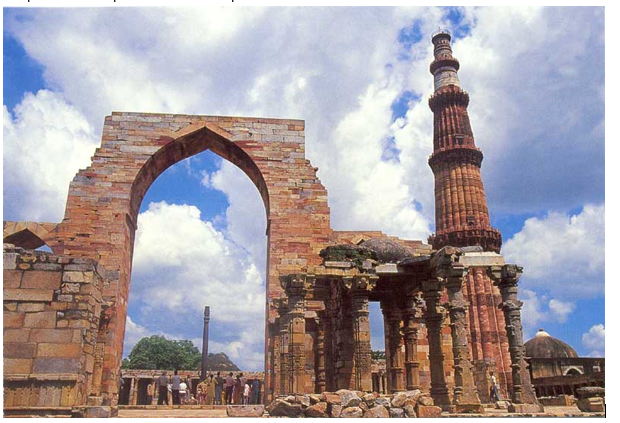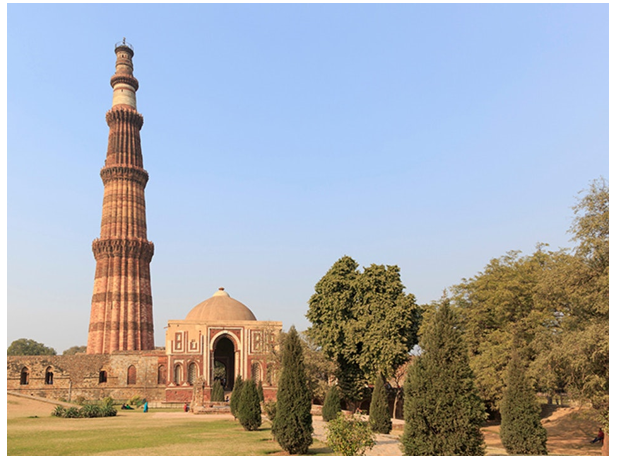History: Culture and Scientific developments in Medieval India
DRDO developing body suits for medical staff, five layer N99 masks, hand sanitizer and ventilators

Meet Aham! Your New Virtual Assistant Providing Information on COVID-19 in 7 Indian Languages

UNICEF supplies arrive in Italy to support COVID-19 response

TIFR comes out with package of engaging and illuminating communication materials

Google's Tilt Brush app debuts on PlayStation VR

Cultural and scientific development in Medieval India
- The coming of the Turks inaugurated a new era in the history of Indian architecture, the Turks brought with them architectural ideas developed in Persia, Arabia and Central Asia.
- They came into contact with the traditions that had already been developed in India. The interaction of these two traditions resulted in a new synthesis of architectural styles. The rulers of the Sultanate were great patrons of architecture and under them the process of synthesis started.
- It continued with many regional variations in the different kingdoms. During the Mughal period the flowering of this synthesis took place and some of the greatest monuments of India were built. Based on the interaction of the two traditions a unique Indian style of architecture was developed in this period.
- One of the greatest contributions of the Muslim rulers was in the domain of architecture. The spirit of synthesis which manifested itself in various other spheres was best expressed in the field of architecture.
- According to Prof. H.K. Sherwani, “Once there was contact between the Perso-Turks and the Hindus, first on the battlefield and then in the bazars of cities, they could not but be impregnated by each other in their culture and their ideals which are so visibly enshriaked in medieval architecture, art and literature.”
- For a proper understanding of the architecture of this period, it would be desirable to have an idea about the characteristics of the Muslim architectures as well as the Hindu architectures the Muslim had evolved a architecture which was conditioned by the learning characteristics of Muslim mentality, practical needs of their religion and worship and the geography of their region.
- The salient features of the Muslim architecture were massive and extensive buildings aspiring domes, tall minarets, lofty portals, open courtyards, huge walls all bereft of sculpture. The Hindus architecture on the one hand was characterised by vastness, stability, majesty, magnificence, sublimity, and infinite richness.
- The Hindus extensively decorated their buildings with beautiful flowers, leaves and various deities. When these two diverse cultures and architecture came into contact with each other, a new architecture came into existence which has been described as Indo-Muslim architecture. This architecture was quite different from other architectures prevailing in India like these of Jaunpur, Bengal, Bijapur. Gujarat etc.
Factors Responsible for the Blending:
The factors responsible for the blending of the fusion of the two cultures can be summed up as follows:
- The Muslim rulers who came to India were essentially military adventurers and did not bring any craftsmen or sculptures with them. They had, therefore, to depend on the local craftsmen for the construction of their buildings. The Indian masons who possessed sufficient experience executed these buildings in their own manner and unconsciously introduced Hindu architectural designs in the Muslim buildings.
- The early Muslim rulers constructed their palaces, mosques and other buildings out of the materials acquired from demolition of Hindu temples and other buildings. A large number of mosques of this period were constructed by destroying certain portions of Hindu temples and making the necessary changes in the buildings according to the Islamic requirements. The Muslim rulers, particularly dismantled the Sikhars and roofs and erected domes and lofty minars.
- In addition, the spirit of toleration and harmony was also to a large extent responsible for the synthesis of the two architectures.
Difference between Hindu and Muslim Architecture:
- For a proper understanding of the Indo-Islamic architecture, which was involved as a result of the synthesis of the Hindu and Islamic architecture, it is desirable to have an idea about these two systems of architecture. The Hindu art was decorative and gorgeous, while the Islamic art was characterised by simplicity.
- The Hindu art was decorative which meant that they used rows of pillars and long beams to span the spaces. The Muslim art was arcuate, which means they used arches to bridge the spaces and erected graceful domes. Another outstanding feature of the Hindu architecture was its solidarity and beauty. The Hindu temples had lofty ahikhars.
- The Hindu architecture possessed infinite richness and variety of sculpture. They conveyed meaning by iconography and carved figures on the buildings. Usually their monuments were enriched with rich idols of divinities.
- In short, the Hindi buildings possessed richness of ornaments and variety of moulding. The Muslim buildings on the other hand were simple and spacious, their walls were plain and smooth faced. As Muslims were iconoclast, they did not represent any figures on the walls for the ornamentation of the walls. They only used colours and other ingenious geometric patterns.
Indo-Islamic Architecture:
- Though the Hindu and the Muslim architecture possessed the distinct features of their own, the mingling of the two led to the rise of a new school of architecture sometimes designated as “Indo-Islamic architecture”.
- Certain scholars have described it as “Indo Saracenic” or “Pathan”. However, scholars like Sir John Marshall and Dr. R.C. Majumdar hold that the Indo-Islamic art was neither merely a local variety of Islamic art nor a modified art of Hindu architecture.
- It represented a blend of Brahmanical, Buddhist and Jain styles with those of western and central Asia and northern African styles which the Muslims brought with them to India. It is very difficult to ascertain how much this architecture owed to the Hindu style and how much to the Islamic system.
- The historians have not been able to arrive at any agreed conclusion whether the Hindu art or the Muslim art dominated in this synthesis. While Prof. Havell holds that the Hindu influence was abundant and rich in the medieval art. Ferguson and Smith hold the view that the Hindu influence was negative.
- Sir John Marshall has best brought out the influence of the two architectures in these words, “Indo-Islamic architecture derives its character from both sources though not always in equal degree.” He further says that the Muslim art is indebted to Hindu art for its grace and strength.
Delhi style of architecture:
- Though in the beginning the Muslim architecture was light and graceful, in course of time it became heavy and solid. The Muslim buildings erected during the times of Qutb-ud-Din Aibak are an example of this type of architecture. This style was used in Delhi and in its vicinity and that is why it is also known as “Delhi style of architecture”.
- The first famous building built by Qutb-ud-Din was the famous Quwwat-ul- Islam mosque at Qila-i-Rai Pithaura in Delhi, which was completed in 1199 A.D. It was completed on the plinth of Hindu temple out of the materials of 27 Hindu and Jain shrines which were demolished by the invaders.
- The major part of this mosque was retained in original with some modification which were ended to make it a “Muslim House of prayer”. The images and carving were either defaced or concealed. Certain Muslim designs and ornaments and calligraphic reproduction from the Quranic texts are other features of this monuments.
- The subsequent Sultans made many additions and modifications to this mosque. For example, Iltutmish enlarged the Quadrangle and made it almost double in size. The additions made by him were more Islamic than Indian. Similarly, Ala-ud-Din Khilji added a prayer Chamber to the mosque, and started the construction of a minar, a rival to the Qutab Minar, but could not complete the project due to his death,
- Dhai Din Ka Jhompara at Ajmer built by Qutb-ud-Din Aibak in 1200 A.D is another building of this style. It was also built with the material of demolished temples and is more spacious and dignified than Quwwat-ul-Islam mosque at Rai Pithaura, Delhi. This Jhompara was a Sanskrit college and a Jain temple before its conversion.
- The legend that it was built in two and half days is a myth and such a magnificent building could not have been built in such a short period. Prof. S.K. Saraswati says, “Magnificent as it was it is a perfect example of mathematical precision and technic call skill; but there are many features in it that sufficiently betray a certain limitation on the part of the designer in respect of imagination as well as of artistic vision; on no account can it be regarded as an artistic triumph.”
Another important building which was originally intended to be a place for Muazzin (to call the faithful to the prayer) and popularly known as Qutab Minar was started by Qutab-ud-Din Aibak on behalf of Mohammad of Ghur.
- However, he completed only one storey and the building was completed by Iitutmish. Subsequently, Firoze Tughlaq also made certain modifications. Sikander Lodi is also said to have carried out some repairs in the upper storeys. The Minar is nearly 238 feet high.
- Each of the five storeys, “is surmounted by a projecting gallery encircling the tower, supported by large stone brackets, decorated with lovely comb-work, the finish and elaboration of which is not surpassed by the base and twenty yards at the top. Inside there is a circular staircase. It is tapering upward in convex fluting, made solid and earthbound by four circular balconies and blunt peak. The Qutab Minar is one of the highest stone towers in the world.”
- Some scholars are of the opinion that Qutab Minar is of Hindu origin and the Muslims only re-carved on its outer surface. This view seems to be based on the fact that certain Devnagari inscriptions are present on the tower.
- It is probable that the stones bearing these inscriptions might have come from certain other Hindu places. Sir John Marshall does not agree with this view and holds that, “the whole conception of the minar and almost every detail of its construction and decoration is essentially Islamic. Towers of this kind are unknown to the Indians, but to the Muhammedans they had long been familiar, whether as ma’zinas attached to mosques or as free standing towers like those at Ghazni”.
- Percy Brown says that the Qutab Minar “as a whole is a most impressive conception, the vivid colour of its red sandstone, the changing texture of its fluted storeys with their overlay of inscriptional bands, the contrast between the alternating spaces of plain masonry and rich carving, the shimmer of the shadows under the balconies, all combine to produce an effect of marked vitality.”
- According to Will Durant, “The Qutab Minar exemplifies the transition. It was part of a mosque begun at old Delhi by Qutbuddin Aibak; it commemorated the victories of that bloody Sukan over the Hindus, and twenty seven Hindu temples were dismembered to provide material for the mosque and the tower.” It was intended for the muazzin and also it was to serve the purpose of memorial of the conqueror’s triumph.
- According to an inscription carved on its surface, this grand tower was raised to cast “the shadow of God over the East and over the West.” Prof Vincent Smith also says, “All things considered, there is no reason to doubt the statement that the Qutab Minar was designed by a Muhammedan architect and built by Hindu craftsmen.”
- Another prominent building of this period is the tomb at Mulkapur about three miles from Qutab Minar. This mausoleum of lltutmish’s eldest son, Nasir-ud-Din Mahmud, called Sultan Ghari was built by lltutmish and decoration is dose purely in Hindu style.
- Though arches and domes have been used prominently but they seem to have been built on the Hindu corbel principle. Yet another notable building of the early Sultanate period is the tomb of lltutmish built of red stone.
- This is a grey Quartzite. Though this building has certain Hindu decorative features. It is a beautiful example of nearly Persian art. The tomb bears Saracenic, arabesques and Quranic inscriptions and the walls are sumptuously sculptured. It is perhaps the first important monument in which use of squinch arches has been made.
- Thus we find that from the times of lltutmish there was a marked increase in the Islamic elements in the construction of buildings. The other important building constructed by lltutmish are Bauz i-Shamsi, Shamri-Idgah and the Jami- Masjid.
- There was a comparative lull in the building activities for some time after the death of lltutmish. This was probably due to the political confusion prevailing in the country. The only building which came up during this period was tomb of Balban situated in South East of Qila-i-Rai Pithaura which is now in ruins. The chief significance of this building is that its arches are built on the pattern of radiating voussoirs.
Science and Technology in India
- India already had commercial and cultural relations with Greece, Iran, Afghanistan and Central Asia since pre-historic times.
- A characteristic feature of this period is that with the advent of the Muslims, seeking service and opportunity in India, it came into close contact with the Muslim intellectual world and the cross fertilization of scientific ideas started.
- Muslims started migrating to India more and more after 1258 A.D. due to the Mongol invasion of Iran, Iraq and Central Asia; some of them were also astronomers, mathematicians and physicians.
- “With the establishment of the Ghaznavid and Mughal rule in India the Greek or rather more advanced Ptolemic astronomy in Arabic version reached India and began to be studied and taught at first exclusively among the Muslims and gradually among the selected Hindu astronomers who appreciated its merit.”Al-Biruni(d. 1050 A.D.) claims that he had translated the Elements of Euclid and the Almagest of Ptolemy into Sanskrit but these translations are not available. In any case, the Arabic versions of these two books were first introduced by the Muslims in India.
- It is stated “towards the close of the 12th Century A.D. mathematical books in Arabic began to trickle into India.
- Some Indian Muslim mathematicians and astronomers settled in India knew these Arabic translations and they translated them into Persian.
- These translations and several commentaries mostly in Persian on the works of Euclid, Archimedes, Theodosius, Apollonius and Ptolemy are available in manuscripts in the different libraries of India and abroad. Thus the Greco-Arab astronomy and mathematics were introduced into India and studied.
- Some of them were taught as text books in the educational institutions in late medieval India from the time of Akbar (d. 1605 A.D.) who made astronomy and mathematics compulsory subjects to be studied.
- Another characteristic worth mentioning is that the first substantial contact between the Ayurveda and Unani (Greco-Arab) systems of medicine started during this period which resulted in the mutual enrichment of both in therapeutics, materia medica and pharmacology.
- These two systems of medicine flourished because they brought relief to the suffering and the sick.
- The two main causes of the development of chemistry and alehemy were the practice of Ayurveda and the need of textile industry.
- Among other characteristics mention may be made of the development of the Rasacikitsa school of medicine with emphasis on mercurial and other inorganic preparations and the development of Tantras and the knowledge of nervous system as developed by them.
Medicine, Chemistry and Alehemy
- The Ayurvedic system of medicine including the Siddha were practised extensively and in the beginning of the 13 th century the Unani system of medicine was also introduced in India when the period of growth and standardisation of Ayurveda had almost come to an end.
- The four Standard works Çaraka Samhitu, Susruta Samhitu, Astungahardaya, Nidana and their commentaries were used by the general medical praetitioners of India (Vaids).
- “Feeling of patients’ pulse as a method of diagnosis of diseases was possibly first introduced during this period as discussed in a text of Ayurvedic medicine, Cikitsutilaka (12th century) by Tisatacarya.”
- Physicians (Tabib) expert in the Unani(Greco-Arab) system of medicine began to migrate from the beginning of the 13th century and this was the first major contact between Ayurveda and Unani medicine in India. Both the systems of medicine were now practised.
- Two different sets of hospitals were established by the Turko-Afghan rulers there the patients were treated according to these systems.
- There were seventy hospitals only at Delhi under Sultan Muhammad bin Tughluq (1297-1348 A.D.) having 1200 Vaids and Tab?bs paid by the State.
- The mutual co-operation and direct contact of the Vaids and Tabibs produced substantial results and led to the mutual enrichment of knowledge.
- Indian pharmacology, materia medica and therapeutics were enriched by the Unani system and camphor, sublimate of landanum and some anesthetics were introduced into the Ayurveda.
Technology
- Without doubt, there was progress in technology but the results of technological advancement were not much applied to solve the socioeconomic problems.
- There is no denying the fact that in so far as technology is concerned, advent of the Turko-Afghans in India resulted in some development due to mutual co-operation between the Hindus and the Muslims and the introduction of new and more advanced technique from Iran, Afghanistan and Central Asia the Muslims.
- It is evident that technology during this period was almost the same as in ancient India which was somewhat improved after the Ghorian conquest.
Chalukyas
Context
Graves of Chalukyan rulers have been found in a village near Huligemmanakolla in Pattadakal of Karnataka’s district.
About
- The discovery was made by explorer Manjunath Sullolliwho says that the place has graves of the family members of Chalukyan rulers.
- There are 11 small temple-like structures in Huligemmanakolla that are believed to be the final resting place of the royal family.
- Chalukyan kings were famous for building gigantic temples with intricate architecture in places such as Aihole, Badami, and Pattadakal in Bagalkot
- Built between the sixth and eighth centuries, these monuments are examples of the best of the architecture of that era in entire South India.
- Though the Chalukyan kings built marvelous monuments and temples, there are no clear details available of the places where they lived.
- Neither they have left behind documents nor evidence of their graves; therefore, explorers are still searching for their graves.
Chaulakyas
- The Chalukya dynasty was established by Pulakeshin I in 543 AD. Pulakeshin I took Vatapi (modern Badami in Bagalkot district, Karnataka) under his control and made it his capital.
- Pulakeshin I and his descendants are referred to as "Chalukyas of Badami".
- Pulakeshin II, the most famous ruler, extended the Chalukya Empire up to the northern extents of the Pallava kingdom and halted the southward march of Harsha, belonging to Pushyabhuti dynasty by defeating him on the banks of the river Narmada.
Architecture
Their style of architecture is called "Chalukyan architecture", "Karnata Dravida architecture" or the “Vesara Style” of architecture, which is the fusion between northern “Nagara” style and southern “Dravida” style.
Badami Cave temples
- Badami cave temples have rock-cut halls with three basic features: pillared veranda, columned hall and a sanctum cut out deep into rock.
Pattadkal temples
- Virupaksha temple
- Papanatha temple
- Mallikarjuna temple
- Sangameshwara temple
Aihole temples
- Lad khan temple
- Durga temple
- Suryanarayan temple
- Ravana Phadi temple
Contributions
- A Southern India-based kingdom took control and consolidated the entire region between the Kaveri and the Narmada rivers.
- The rise of this empire saw the birth of efficient administration, overseas trade and commerce.
- Kannada literature, which had enjoyed royal support in the 9th century Rashtrakuta court found eager patronage from the Western Chalukyas.
- The Chalukyas provided patronage to various religions and traditions such as Jainism, Veerashaiva etc and allowed them to prosper.
The ancient port town of Mamallapuram
Context
The ancient port town of Mamallapuram was selected for the scheduled visit of Prime Minister Narendra Modi and Chinese President Xi Jinping during a two-day second India-China informal summit.
About
- First India-China informal summit: It was held in Wuhan, China on April 27-28, 2018, to exchange views on overarching issues of bilateral and global importance, and to elaborate their respective visions and priorities for national development in the context of the current and future international situation.
About Mamallapuram:
- Mahabalipuram or Mamallapuram is a historic city and UNESCO World Heritage site in the state of Tamil Nadu.
- Mahabalipuram was the second capital of the Pallavas who ruled Kanchipuram. Formerly, mahabalipuram was known and called as Mamallapuram.
- It was during the reign of King Narasimha Varman I(630 - 668AD), the name Mahabalipuram was changed. King Narasimha Varman I was a great and valiant warrior. He was given the title Mamalla which means ‘the great wrestler’ so the name was converted from Mahabalipuram to Mamallapuram considering the great king and his achievements.
- During the reign of the Pallava dynasty, between the 3rd century CE and 7th century CE, it became an important centre of art, architecture and literature.
- Mahabalipuram was already a thriving sea port on the Bay of Bengal before this time. A significant amount of coins and other artefacts excavated from this region also indicate a pre-existing trade relation with the Romans even before it became a part of the Pallava Empire.
Art & Architectural Masterpieces at Mamallapuram:
- Shore Temple: The Shore Temple (built in 700–728 AD) is so named because it overlooks the shore of the Bay of Bengal. It is a structural temple, built with blocks of granite, dating from the 8th century AD. It was built during the reign of Narasimhavarman II. It is a remnant of a larger complex of temples and civil structures much of which lie under the depth of the sea now.
- Descent of the Ganges: It is alternatively known as Arjuna’s Penance. Descent of the Ganges is a gigantic open air bas-relief sculpted out of pink granite. The dramatic relief sculpture narrates the tales from Indian epics such as the Mahabharata.
- Pancha Ratha: Pancha Ratha (five chariots) is an architectural ode to Mahabharata’s five Pandava brothers Yudhistir, Bhima, Arjuna, Nakula, Sahadeva, and their wife Draupadi. Thematically and structurally, each ratha is significantly different from the other ones, but all of them were carved out of a long stone or monolith.
KEELADI – An Urban Settlement of Sangam Age
Context
The Tamil Nadu Archaeology Department (TNAD) has stated that Keeladi excavations reveals sangam age to be much older than believed earlier.
About
The Tamil Nadu Archaeology Department (TNAD) has stated that Keeladi excavations reveals sangam age to be much older than believed earlier.
Where is Keeladi located?
Keeladi is a small village near Silaiman on the border between Madurai and Sivagangai districts in Tamil Nadu, and also the site on the banks on Vaigai River where remains of ancient Sangam culture have been found.
What is the Significance of Keeladi finding?
- Generally, the Age of Sangam is considered between 3rd century BCE and 3rd century CE. But, the available Accelerator Mass Spectrometry (AMS) dates obtained for the Keeladi carbon samples push the date of Tamil-Brahmi to 6th century BCE. These scientific dates force to re-assess the widely held date of Sangam Age.
- The AMS dates obtained from Kodumanal and Porunthal pushed the date of Tamil-Brahmi to 5th century BCE. But, the Keeladi AMS dates further pushed the date to a century earlier i.e., 6th century BCE.
- As high literacy level is well achieved in 6th century BCE, naturally the beginning of historic period in Tamil Nadu goes back to 6th century BCE. The available evidences clearly suggest that the Early Historic period of Tamil Nadu begins in 6th century BCE and the Iron Age begins in 2 nd millennium BCE.
- It is generally believed that second urbanization observed in Gangetic valley did not occur in Tamil Nadu. But, the Keeladi excavation clearly suggests that the second urbanization too happened in Tamil Nadu in 6th century BCE.
What is Sangam Age?
- The Sangam Age constitutes an important chapter in the history of South India. According to Tamil legends, there existed three Sangams (Academy of Tamil poets) in ancient Tamil Nadu popularly called Muchchangam.
- These Sangams flourished under the royal patronage of the Pandyas.
- The first Sangam, held at Then Madurai, was attended by gods and legendary sages but no literary work of this Sangam was available.
- The second Sangam was held at Kapadapuram but the all the literary works had perished except Tolkappiyam.
- The third Sangam at Madurai was founded by Mudathirumaran. It was attended by a large number of poets who produced voluminous literature but only a few had survived.
- These Tamil literary works remain useful sources to reconstruct the history of the Sangam Age.
Historical importance of Madurai:
- It is one of the ancient cities in India that enjoyed continuity in the history from Pre-historic times. Due to its cultural prominence, Madurai is described as “The Athens of South India”.
- It is also well known as a great centre for learning from very early times. As the seat of the Tamil academy called the Sangam, it wielded great influence in the literary and cultural fields.
- During the glorious rule of Pandyas, Madurai had overseas connections for both commercial and cultural activities.
- The Pandyas and their capital city Madurai were well known to the Ancient Greeks and Romans.
- Megasthenese, the Greek ambassador of Seleukos Nicator at the court of the Chandra Gupta Maurya (320 B.C.), in these accounts gave a vivid picture of a South Indian Kingdoms.
- Strabo (C. 25. B.C.) stated that a Pandya king sent an embassy to the Roman Emperor Augustus.
- Pliny (C. 75 A.D.) mentioned about the Pandya, King Pandya and his capital Madurai.
- Ptolemy (C. 130 A.D.) also referred Madurai as the royal city of the Pandyas.
- The Arthasastra of Kautilya, while describing the trade between Northern and Southern India, spoke about the pearls and muslins of the Pandya country.
- The astronomer Varahamihirar referred the Pandya kingdom in his Brhatsamhita.
- The earliest datable Ashoka’s rock edicts Nos. 2 and 13 mention the South Indian Kingdoms viz, Chola, Pandya, Satyaputra and Keralaputra.




